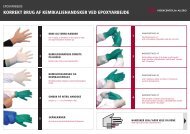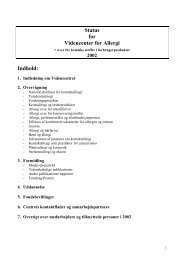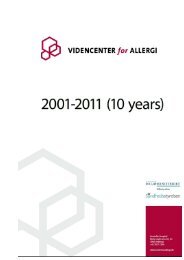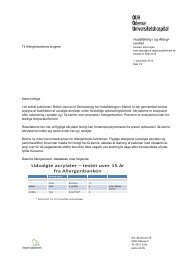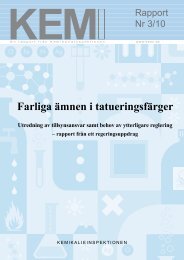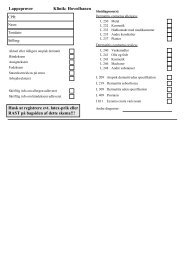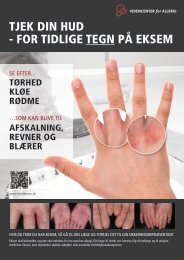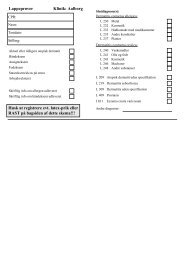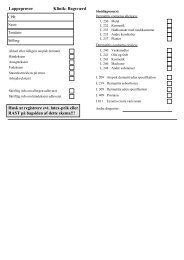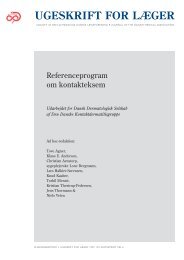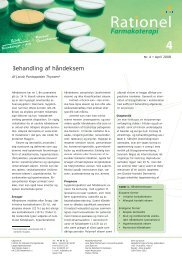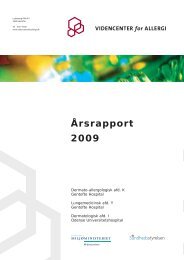Charlotte Devantier Jensen.pmd - Videncenter for Allergi
Charlotte Devantier Jensen.pmd - Videncenter for Allergi
Charlotte Devantier Jensen.pmd - Videncenter for Allergi
Create successful ePaper yourself
Turn your PDF publications into a flip-book with our unique Google optimized e-Paper software.
The aim of the thesis was to characterize the allergic response<br />
to MDBGN in pre-sensitized individuals. During 3 clinical<br />
elicitation studies, sensitized subjects were exposed to the preservative<br />
in experimental use tests designed to resemble the<br />
actual use-situation of cosmetic products. Exposure conditions<br />
in the trials were varied in order to examine different aspects<br />
of the allergic response.<br />
The focus of this thesis was decided based on the alarming<br />
rise in the frequency of eczema patients sensitized to MDBGN<br />
in Europe and the urgency of a safety re-evaluation of MDBGN.<br />
Results obtained from the experimental studies were intended<br />
to contribute to a risk assessment and an evaluation of the existing<br />
threshold limiting values of MDBGN in cosmetic products.<br />
However, in the initial stages of this project a decision<br />
was made to ban the use of MDBGN in leave-on cosmetics in<br />
Europe. This ban will be effective “until appropriate and adequate<br />
in<strong>for</strong>mation is available to suggest a level of the preservative<br />
in leave-on products that poses an acceptable risk to<br />
the consumer…” 79 . Following this development, it was decided<br />
in the first trial of this thesis to investigate the risk of utilizing<br />
MDBGN in rinse-off products, as the preservative will continue<br />
to be allowed in this type of products at the current permitted<br />
level of 0.1%. In the second trial, the influence of the<br />
frequency of applications on the elicitation potential was examined,<br />
and in the third trial, the significance of previous allergic<br />
contact dermatitis when re-exposed was investigated.<br />
Contact allergy to the preservative methyldibromoglutaronitrile 13<br />
AIMS OF THE THESIS<br />
AIM OF TRIAL I – ELICITATION STUDY OF<br />
MDBGN IN A RINSE-OFF PRODUCT<br />
The aim of the trial was to investigate the allergic response<br />
elicited in pre-sensitized individuals from exposure to a rinseoff<br />
product preserved with the maximum permitted level of<br />
MDBGN, 0.1%. The results may be used in a risk assessment<br />
of MDBGN and in an evaluation of the existing threshold limiting<br />
value of the preservative in rinse-off cosmetic products.<br />
AIM OF TRIAL II – EFFECT OF SINGLE VERSUS<br />
REPEATED DAILY EXPOSURE OF MDBGN<br />
This trial examined whether one high-dose exposure a day of<br />
MDBGN is more or less potent than several low-dose exposures<br />
with regard to elicitation of allergic contact dermatitis in<br />
pre-sensitized individuals. This knowledge may be useful in<br />
the risk assessment and regulation of products potentially used<br />
multiple times a day.<br />
AIM OF TRIAL III – INVESTIGATION OF RE-<br />
TEST REACTIVITY BY BOTH PATCH AND USE<br />
TEST WITH MDBGN IN SENSITIZED<br />
INDIVIDUALS<br />
It has been shown that skin with healed allergic contact dermatitis<br />
is re-test hyperreactive <strong>for</strong> up to several months after<br />
the dermatitis has healed. This trial aimed to investigate whether<br />
skin with previous dermatitis elicited by MDBGN showed an<br />
augmented response compared to normal and irritated skin<br />
when re-exposed by both a patch test challenge and in a use<br />
test with a liquid soap preserved with MDBGN.<br />
Forum <strong>for</strong> Nord Derm Ven Vol. 10, 2005 – Suppl. 8




